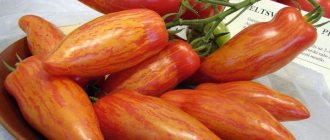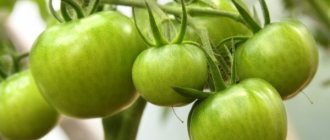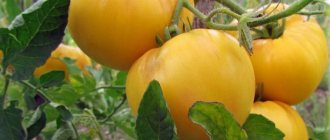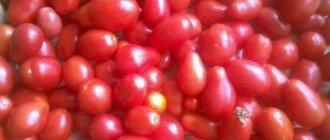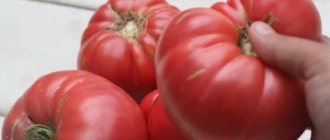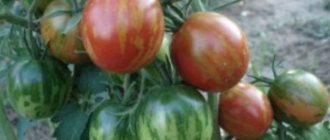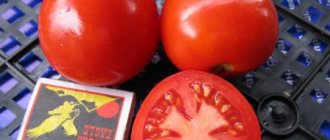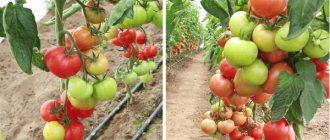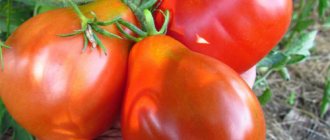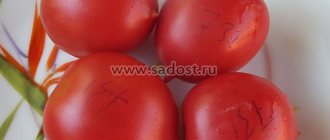It is possible to do what you love and get amazing harvests of exotic fruits. To do this, it is enough to choose suitable hybrid varieties, such as the Sasher F1 tomato. Its highlight is its black color and wonderful taste.
| Height | Landing location | Ripening time | Fruit color | Fruit size | Origin | Fruit shape |
| Tall | Greenhouse, Open ground | Early ripening | Black | Average | Hybrid | Round |
Top dressing
Gardeners agree that the best fertilizer is rotted manure, which should be applied to the soil at the rate of 5-10 kg per 1 m2.
The soil also needs mineral fertilizers per 1 m2: 10-15 g of urea, 40-50 g of superphosphate, potassium magnesium or potassium salt 20-25 g.
Seedlings should be planted 20 days earlier than the main planting of seedlings. This is necessary to speed up the harvest.
Attention! Since plants are planted ahead of schedule, it is necessary to additionally protect small bushes from possible frosts.
Advantages of the variety
Despite the fact that Sasher tomato seeds appeared on Russian shelves relatively recently, the variety has already become a favorite among many gardeners. Reviews from summer residents confirm the early ripeness and high yield of the crop, which is 25 kg per bush.
Additional advantages of the variety:
- Tomatoes are grown in film shelters 2 times a year: in spring and autumn.
- The plant is resistant to temperature changes and sudden cold snaps.
- The hybrid is immune to tomato diseases and root rot.
- Ease of care saves time for gardeners.
- Harmonious ripening of fruits.
- Harvesting in a short time.
- The commercial quality of tomatoes increases their demand in the consumer market.
- The universal purpose allows you to consume tomatoes fresh and use them in cooking.
- Long shelf life and transportability allow tomatoes to be transported over long distances.
These and additional qualities distinguish the Sasher tomato from other hybrids of Russian and foreign selection, which contributes to its rapid popularity.
How to protect seedlings
Plant protection can be ensured by covering them with paper caps and plastic bottles without a bottom.
You may be interested in: Dates for planting tomato seedlings in open ground and greenhouses according to the garden calendar Favorable days for planting tomatoes for seedlings in 2021 according to the lunar sowing calendar Favorable days for picking tomatoes in 2021 after germination: timing of picking tomato seedlings in the table by day
Attention! It is necessary to water the seedlings only at the roots. The use of sprinkling method is excluded.
It is worth noting that tomatoes suffer less from drought than other garden plants. This is because they are able to extract moisture from the soil air. Loosening the soil will help them with this. Thus, loosening the soil several times can replace one watering.
Attention! If there is insufficient moisture, you should carefully consider fertilizing. Since an excess of organic matter is dangerous because the tomatoes can burn.
Patronage of plants
Plants of this hybrid are considered resistant to many diseases. Nevertheless, with a large amount of infection, it is desirable to stimulate the plant’s defense mechanisms, at least using immunity inducers, such as Immunocytophyte.
Tomato plants can be damaged by wireworms, whiteflies, Sovdepiya caterpillars, and, less commonly, the Colorado potato beetle and slugs. To protect against wireworms, there are purely chemical and biological preparations. Nemabact is one of the last resorts. It is recommended to spray the oncoming whitefly with Inta-vir or Iskra.
Plant garter
The sasher differs in that several fruits ripen simultaneously on one fruit branch. Thus, the plant needs support. It's all about the pressure of the tomatoes on the shoots, which threatens to break the stem.
Gartering is done in two ways:
- Column. Having stepped back a little from the root of the plant, either a wooden stick or a metal rod is inserted into the soil. The plant stem should be attached to this support using small pieces of fabric.
- trellis. At the beginning and end of each row, two supports are installed, to which the wire is subsequently attached. And plants are tied to it.
Tomato Pablo: variety description, yield and cultivation with photos
Tomato lovers will appreciate the fruit of modern selection - the Pablo f1 tomato. Numerous advantages have ensured that the variety is in demand among gardeners in different regions of Russia. The originator of the plant was the Japanese company Sakata, and today the new product was officially entered into the state register.
General information about tomato
The Pablo variety of tomato is suitable for growing in greenhouses and open beds. Description of the appearance and characteristics of the plant:
- early ripening, the period before harvest is 95 days;
- indeterminate, has unlimited growth;
- tall, reaches 2 meters;
- powerful root system;
- good foliage;
- slightly ribbed;
- average yield, over the summer they get up to 4 kg per 1 sq. meters of landing;
- the number of fruits in the cluster is 5-6 pieces;
- good adaptive abilities;
- ease of care;
- resistance to most diseases of the nightshade family;
- possibility of transportation over long distances without loss of presentation;
- keeping quality.
Tomatoes have become a novelty among hybrid varieties. The ability to bear fruit in unfavorable weather conditions and poor soils has made it possible to grow tomatoes in all regions of Russia. Technical data and appearance of the fruit:
- flat-round, leveled shape;
- dense;
- thin skin;
- large, average weight 200 grams;
- red color when ripe;
- sweet taste;
- fleshy, not watery;
- fragrant.
Recommendations for cultivation
The plant prefers the seedling method of planting. Preparatory work begins 2 months before the expected planting date. When preparing seedlings, it is recommended:
- sow seeds to a depth of 1-1.5 cm;
- after planting, cover the containers with film;
- maintain temperature 21-25 degrees;
- after the sprouts appear, remove the film, transplant the tomatoes into separate pots and move them to the light;
- regular watering;
- picking.
IMPORTANT! Before planting, seedlings should be hardened
For 1 sq. Place no more than four tomatoes per meter of land according to a 40 x 60 cm pattern. The plant is undemanding; mandatory care measures include:
- watering with water not lower than the air temperature;
- feeding with complex mineral fertilizer, at least 4 times during the summer period;
- regular loosening and weeding of the soil;
- pinching, forming a bush into one stem;
- installation of supports and tying to the trellis with synthetic materials.
Gardeners' opinion
Good afternoon. I've heard positive reviews about Pablo's tomato. This summer I tried to grow it and was pleased.
The tomato bore fruit in the cold summer, withstood all unfavorable conditions, and had good yields. Suitable for cultivation in the northern regions of Russia. There were no difficulties in care. In greenhouse conditions I received 3 kilograms of berries from 1 sq. meters of landing. I recommend!
Valerian Egorovich, 54 years old.
Good afternoon! I recommend the Pablo variety to all tomato lovers. It tolerates heat well and does not require close attention. Suitable for growing in open ground in the southern regions of Russia. Ripe berries are suitable for salads, twists and pickles.
Growing in a greenhouse
Due to its short stature, Sasher is suitable for growing in a greenhouse.
Planting of seedlings in a greenhouse occurs two months after the appearance of the first shoots.
Caring for plants in a greenhouse involves watering, as well as timely fertilizing. Watering is not done often, but abundantly. Approximately once a week, about 5-7 liters of water per hole.
Important! Care must be taken to ensure that the soil does not dry out. And loosen it in a timely manner.
Soil fertilization is carried out about four times during the season:
- the first time during landing;
- the second time during flowering;
- the third and fourth during fruiting as needed.
Description and characteristics of the variety
Tomato Sasher F1 is an indeterminate tall hybrid. Even in extreme conditions it has good productivity. The fruits set in hot weather and cold weather.
Features of the bushes:
- shoot height 1.8-2 m;
- semi-spreading bushes;
- moderate branching;
- there are 7-8 fruits on the clusters.
Ripening dates are early - 90-96 days from germination. Fruiting lasts from mid-July until the first autumn frosts. Description of fruits:
- average weight 150-180 g;
- dark color;
- round shape;
- the pulp is fleshy, low-seeded;
- The skin is strong and does not crack.
The taste is dominated by sweetness, with notes of delicate sourness.
The best tomato varieties for 2021
When choosing tomatoes for their plot, gardeners, first of all, rely on varietal or hybrid characteristics. Productivity is the most important criterion on which the quantity and quality of the harvest depends. Sometimes it can be difficult to choose the right option from the rich variety of tomatoes for open ground and greenhouses. Then varieties are selected depending on the growing region, ripening period, degree of disease resistance and other factors.
A huge number of species with excellent yields are intended for growing vegetables in the open air. Low-growing bushes with large fruits are one of the advantages of tomatoes for the soil. Such heat-loving plants are easier to care for and do not require complex agricultural practices.
According to ripening period
Tomatoes, like other vegetable crops, are characterized by different ripening periods, from early to late.
| Ripening period | Ripening of fruits after the appearance of the first shoots | general characteristics | The most productive tomatoes (2020) |
| Ultra-early ripening | On day 80-85 | The fruits are small, juicy, and low in sugar. The height of the bush is no more than 50 cm. Not suitable for preservation. | Little Red Riding Hood, Pride of Russia, Benito, Superstar, Valentina, Marisha, Maksimka |
| Early ripening | For 90-95 days | Small, delicate fruits, average yield. Suitable for canning and salads. Bushes grow up to 70 cm | Agatha, Riddle, Augustine, Lyana, Sanka, Buyan, Lakomka, Amur standard, Grandmother's kiss |
| Mid-early | On days 100-103 | The fruits are juicy, small, aromatic. The purpose is universal. Bush shape - compact | Openwork, Babushkino, Pulka, Red Giant, Russian Soul, Cardinal, Flamingo |
| Mid-season | On day 100-115 | High taste, excellent yield. There are both low-growing and tall varieties | Scarlet Candles, Hybrid Basket, Stresa, Intuition, Black Baron, Pudovik, Pink Honey |
| Late ripening | On day 120-130 | Excellent fruit taste, high yield, universal purpose. Good keeping quality and transportability of fruits | Giraffe, Cosmonaut Volkov, Titan, Rio Grande, Russian size, King of Kings, Rocket, Premier |
The ripening time, color and shape of tomatoes depends on the variety.
Usually early-ripening vegetables with not large fruits and not a large harvest, but with a quick, friendly yield of ripe tomatoes. Mid-season ones also have medium sizes. Late ones are usually difficult to care for, but it is among them that you can find champions in weight, but there are not many such beauties on the bush.
Every year, breeders create new species with high quality indicators. In stores you can buy specialized varieties of tomatoes designed for growing in certain climatic conditions. Classification by regions of Russia:
- for the Moscow region: Champion, Sweet Bunch, Honey, Pink Elephant, Fireworks, Bull's forehead;
- for the southern regions: Torch, Novice, Titan, Winner, Bison, Ermak, Gift, Mikado;
- for the middle zone: Bull's Heart, Black Prince, Uzbek (Yusupov), Moskvichka, Snowdrop, Big Brother, Spasskaya Tower;
- for Siberia: Siberian heavyweight, Ultra early ripening, Sanka, Abakan pink;
- for the Urals: Coin, Bull's Heart, Button, Countryman, Yellow Buyan, Bullfinch, Demidov;
- for the far north: Snowy Tale, Ballerina, Ladyfingers, Berdsky Large, Countryman, Oak, Gina.
READ MORE: Cucumber competitor reviews variety description photo characteristics
An unpredictable, cold or, conversely, excessively warm climate is not a reason to refuse to grow tomatoes in open ground. Thanks to selection, varieties have been developed that grow and develop well in any terrain.
To obtain a rich harvest, you need to choose tomato varieties not only with the appropriate characteristics. It is necessary that this criterion be supplemented by such an indicator as disease resistance.
Late blight, root rot, tobacco mosaic, cladosporiosis are diseases that most often affect plantings of heat-loving crops.
A catalog of tomatoes that can withstand the onslaught of various diseases:
- Blitz;
- Koenigsberg;
- Geisha;
- Betta,
- Anyuta;
- Bohemia;
- Chio-chio-san;
- Tatiana;
- Puzata hut;
- Lights of Moscow;
- Yablonka Russia;
- Crimson giant.
Unfortunately, there are no varieties that are 100% resistant to infections. But there are hybrids that produce a harvest until the active phase of many fungal diseases and infections begins.
Having a good greenhouse at your disposal, you can get fresh tomatoes to your table all year round. Greenhouse varieties are suitable for preparing salads or canning. Excellent salad tomatoes can be obtained from the following varieties:
- Geisha;
- Fairy gift;
- Andromeda;
- Eagle beak;
- Pink Angel;
- Pink Pearl;
- Fatalist;
- Scarlet caravel;
- Amana orange
The best varieties for preservation:
- Auria;
- Banana legs;
- Pink raisins;
- Rajah;
- Baba;
- Alexander the Great.
Cherries are sweet, small tomatoes that grow well both outdoors and in a greenhouse, but small-fruited vegetables tend to be more productive in protected beds. Magic Harp F1 and Yellow Caramel F1 are hybrids whose fruit weight does not exceed 25 g.
When choosing a vegetable for a greenhouse, many rightly give preference to tall and high-yielding varieties. But low-growing plants, which usually have an early ripening period, as well as mid-ripening tomatoes, are also excellent for polycarbonate shelters in all regions of Russia.
For open ground, breeders also offer species with high yields of hybrid origin; they are resistant to diseases and temperature changes. The best tomato varieties of 2020:
- Intuition F1 is one of the best tomato hybrids for picking with trusses, mid-season, from germination to harvesting the first vegetables - 110 days.
- Katya F1 is an early ripening hybrid. The fruits weigh 90-130 g and ripen simultaneously. From 1 m² you can harvest more than 10 kg of fruit per season.
- Search F1 – unpretentious and at the same time tasty tomatoes. The hybrid withstands cold weather and is immune to most diseases. The bushes are strewn with small red fruits, which are excellent for pickling and canning.
- Blagovest F1 is an early-ripening hybrid. The fruits are round, glossy, with slightly pronounced ribbing. From one bush you can collect up to 5 kg of fruit.
- La la fa F1 - has excellent consumer qualities, high yield and unpretentiousness. The average weight of the fruit is 140-170 g. From 1 m² you can harvest up to 20 kg.
- Vladimir F1 - has a high yield and is suitable for cultivation in any type of soil. High productivity throughout the entire fruiting period.
- Beef King F1 is an early maturing Dutch hybrid. The tomatoes are round, dense, smooth. From one bush you can collect up to 4-5 kg. Resistant to low temperatures and diseases.
- Ashdod F1 – tomatoes with smooth, dense skin. Fruit weight is from 110 to 140 g. The pulp has a bright burgundy color.
- Tanya F1 is a hybrid from the Netherlands with excellent immunity, dense structure, and good yield. The fruits have a regular round shape, weighing 150-200 g. They tolerate transportation well.
If the designation on a bag of planting material is F1 – hybrids of tomatoes (or other plants) of the first generation, F2 – of the second, and so on.
Exceptional taste, fruit weight, constant yield, disease resistance, adaptation to weather conditions are the advantages of hybrids over tomato varieties.
Reviews
My favorite tomato variety in 2021 is Idol, medium-sized, very tasty, productive. I planted seedlings on March 20, the first fruit was picked on June 20. The bushes bear fruit for 3 months. The most successful cherry variety is Black Cherry, very tasty and productive, the most favorite tomato of children.
I like the fruits to be large and regular in shape. Therefore, I prefer the varieties Early Rose, Peach, Heavyweight of Siberia and Pink Fig. This year I raised Grandma's Secret. The bush is determinate, the average height is 180 cm. I have never produced kilogram fruits, the maximum weight is 700-800 g. Probably this is because I allow the bush to form into two or three stems.
I never conduct systematic analysis. I analyze when the tomatoes are already picked. I love large, sugary berries. I really like the Pink Giant in taste, but the yield is low. So far, my requirements are relatively met by 2 varieties - Pink Andromeda and Mazarin. Over time (I’m a novice gardener) I’m thinking of finding the optimal variety or hybrid of tomatoes.
Now I mainly grow tomatoes in my dacha. About 20 different varieties. Red, yellow, brown, black. Beauty! Cherry, Cream, Ox heart. Different sizes, different tastes, different ripening periods - from May to October. The main thing is that the weather is warm. I’m not keen on canning, so we use fresh vegetables. If the harvest is good, I give the remaining tomatoes to relatives.
Stability of the harvest from year to year, the ability to adapt to weather conditions, resistance to pests and diseases are important criteria for a reliable tomato variety. In 2021, you can plant both time-tested tomatoes and new elite varieties. The choice depends only on the preferences of gardeners.
Already now, at the beginning of winter, it’s time to think about what tomato seeds to buy for the next season. After all, before planting tomatoes in the garden, you need to grow seedlings. This process is quite painstaking, but the harvest of fresh vegetables will delight the owner and his guests throughout the summer season.
In this article we will try to identify the 10 best varieties of tomatoes, classify hybrids and varieties according to various characteristics, and also recommend the best varieties of tomatoes for 2021.
READ MORE: Sowing cabbage seeds for seedlings, sowing dates
Tomatoes came to Russia from South America; these fruits love the sun and warmth. However, this did not stop breeders from developing tomato varieties suitable for planting even in Siberia.
Today, not a single summer cottage is complete without bushes with tomatoes. After all, a tomato is a very healthy berry; it contains lycopene, an antioxidant that promotes cell regeneration and prevents aging and the development of cancer cells.
In addition, tomato fruits contain a large amount of vitamins A and C and several microelements, which makes this vegetable not only very tasty, but also incredibly healthy.
The versatility of the tomato also played a significant role in its popularity. After all, tomatoes can not only be eaten fresh and added to salads, they are also used to make unique sauces, dried, dried, canned, pickled and even squeezed into juice.
